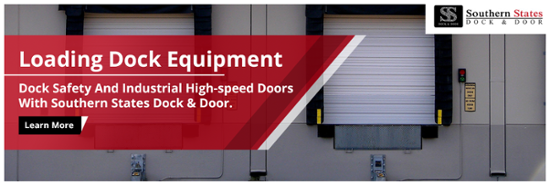Choosing loading dock doors sounds easy enough—all you really need is something that will keep the wind and rain out, right? Well, not exactly. There’s more that goes into choosing the right warehouse dock doors than just “does it fit the entryway?”
The doors you install should help you keep your loading dock operations achieve greater efficiency and safety. They should also contribute passively to your operating costs by keeping out inclement weather and keeping in the climate-controlled air so your HVAC system doesn’t have to work overtime.
But, which kind of loading dock doors are right for your warehouse’s needs? Let’s compare two different kinds of dock doors to evaluate their advantages and disadvantages:
- Sectional dock doors
- Roll up dock doors
What’s the Difference Between a Roll Up and a Sectional Dock Door?
At first glance, sectional and roll up dock doors appear to be very similar—so much so that many laymen don’t know the difference between the two. After all, both types of industrial doors are made of interconnected sections of metal that typically drop or roll down from above to seal a loading dock entryway.
The primary difference between roll up and sectional dock doors is the size of the door sections and the mechanism used to pull the door up and down.
- Sectional Dock Doors. These loading dock doors tend to have larger sections (or “panels”) than their roll up counterparts. Because of the larger panels, these doors tend to be pulled along a track extending into the warehouse area, just above the dock door’s frame. Some sectional doors may replace steel sections with Plexiglas® or other clear materials to let in outside light and provide visibility.
- Roll Up Dock Doors. These warehouse dock doors have much thinner sections that can be rolled tightly. Because of how tightly they can be rolled, they are often stored in coils just above the door opening. Additionally, they are incredibly easy to adjust to loading dock door frames of varying heights.
Which is Better for Your Loading Dock Operations?
The answer to this question depends on what you most want or need in your loading dock. Here are a few comparison points to consider when making the choice between sectional and roll up dock doors:
- Visibility into the Dock Area. A sectional door with a Plexiglas or tempered glass section will naturally improve visibility for workers around the loading even when the dock doors are closed. They will let the sunlight in and give workers the ability to see outside—helping them know who is trying to open the door. The only type of roll up dock door that provides better visibility is the security grille, but these doors are best used in interior areas instead of the loading dock because of their complete lack of climate enclosure.
- Ease of Maintenance. Both roll up and sectional dock doors will require regular maintenance to stay in optimal working condition. However, sectional doors tend to have fewer moving parts and the rails for opening and closing them may still be used even when the motors for pulling the doors are busted. Also, with fewer sections and exposed rails, sectional doors are often easier to service.
- Durability and Security. The overall durability of a loading dock door is often decided by the choice of construction materials and the quality of the build and installation rather than a function of the specific door type. For example, sectional dock doors made of steel will often be much stronger and more durable than aluminum ones—and the same goes for roll up doors.
- Speed of Dock Door Opening/Closing. Both sectional and roll up dock doors have similar open/close speeds, so there isn’t much of a difference there. If the speed of operation is a major concern, consider going with a “high-speed” industrial door, which is a modified form of a roll up or sectional door that increases its open/close speed and simplifies maintenance.
- Space Used. Because they can be rolled into a coil, roll up dock doors tend to take up significantly less space in the warehouse itself than sectional doors. The rail system for a sectional door extends well into the warehouse area, creating an overhead obstacle that operators of taller forklifts have to be wary of.
- Ease of Fit. Because sectional dock doors have smaller sections, it’s often easier to customize them to fit an unusually-sized loading dock than it would be to do so to a sectional door.
In many respects, both roll up and sectional dock doors are nearly equal. However, if you want increased visibility and ease of maintenance, then sectional dock doors might be your best bet. On the other hand, roll up dock doors help to save space and may be easier to customize to fit your loading dock entryway.
Loading Dock Operations Take More Than Just Dock Doors
Of course, choosing the right loading dock door is just one step toward improving the efficiency of your warehouse’s operations. There are many more things to consider, such as loading dock shelters and seals, dock levelers, hazard/warning lights, and other dock equipment.
Contact the experts at Southern States Dock & Door to learn more about how you can make your loading dock operations more effective and efficient today!






